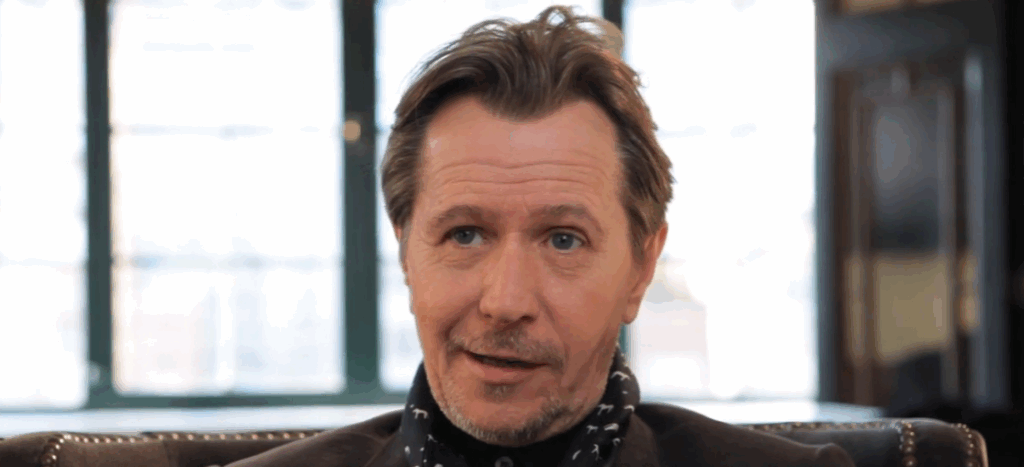Despite Gary Oldman’s enormous influence on the film industry, fans are still curious about his height. Even though he is only 5 feet 8 inches tall, he still has a huge amount of screen real estate. His transformation into larger-than-life roles can be compellingly viewed through the contrast between his physical stature and his artistic presence.
Oldman, who was already fairly close in height, shrank into a shorter man in spirit and body by playing Churchill in Darkest Hour. His performance, which won him an Academy Award, was characterized by a very clear grasp of posture, movement, and vocal delivery rather than lifts or visual tricks. He was able to inhabit Churchill’s persona with remarkable authenticity by utilizing minute details.
Oldman has openly addressed the historical misunderstanding surrounding his height in recent interviews. For years, he thought he was 5’10” until his wife took his height and gave him a different measurement. Discussions about how celebrities view themselves were triggered by that self-deprecating moment, which also served as a reminder to fans that even Hollywood celebrities can be a little out of touch with such details.
Gary Oldman Height: Bio, Career, and Personal Details
| Attribute | Details |
|---|---|
| Full Name | Gary Leonard Oldman |
| Date of Birth | March 21, 1958 |
| Age | 67 years |
| Height (Peak) | 5 ft 8½ in (174 cm) |
| Current Height | Approx. 5 ft 8 in (172.7 cm) |
| Birthplace | New Cross, London, England |
| Occupation | Actor, Filmmaker, Writer |
| Notable Roles | Dracula, Sirius Black, George Smiley, Commissioner Gordon |
| Spouse | Gisele Schmidt (m. 2017) |
| Children | Alfie, Gulliver, and Charlie Oldman |
| Awards | Academy Award, Golden Globe, BAFTA Awards |
| Reference | Celebrity Heights |

Oldman has acted for decades, and his strength on screen has never been determined by his size. His characters exuded menace, complexity, and control in movies like Tinker Tailor Soldier Spy, The Fifth Element, and Leon: The Professional—none of which relied on physical strength. He has always been incredibly successful at taking up mental and emotional space, especially in scenes that call for subdued intensity.
His presence hasn’t been lessened by being positioned next to taller actors like Christian Bale or Michael Caine. Strong dialogue delivery, astute blocking, and well-executed camera work guarantee that Oldman comes across as respected and balanced. His gravity is further enhanced when he is surrounded by a cast of different heights. Oldman commands by nature; he doesn’t have to physically tower.
In the midst of chaos, his Commissioner Gordon was portrayed in the Dark Knight trilogy as a morally grounded figure. Oldman stood his ground, both literally and symbolically, in spite of Cillian Murphy’s sharper jawlines and Christian Bale’s wider shoulders. He exemplified a man whose authority rested on principle and perseverance rather than physical strength through calculated performance decisions.
The discussion of actor height has significantly heated up over the last ten years, particularly in online forums where fan-measured approximations, comparison photos, and red carpet photos are widely shared. But Oldman has handled this situation with cool composure. His strategy has remained grounded—focused on substance over image—while others may cling to illusions.
He exhibits yet another physical change during his role as Jackson Lamb in Slow Horses. In this role, Oldman portrays a slouched, careless spy who bears the emotional burden of regret and determination. Unpolished and unglamorous, it’s a bold character that perfectly captures Oldman’s capacity for physical transformation. He embraces the role’s flaws rather than hiding behind them, which gives it an unexpectedly authentic feel.
Oldman has consistently eschewed typecasting, especially in his choice of roles. His choice of roles demonstrates his extraordinarily broad range, whether he is playing a mousy intellectual in Tinker Tailor Soldier Spy or a vampiric nobleman in Dracula. A new cadence, a new gait, and a reimagined stature—often distinct from his own—are necessary for each role.
Oldman has worked on sets where physical transformation is a part of the story by partnering with well-known filmmakers like Christopher Nolan, Francis Ford Coppola, and Joe Wright. These groups are aware that impact is not dependent on inches, and Oldman performs best in settings where dimension and depth are more important than optical dominance.
Oldman’s career has been used as a benchmark for casting that prioritizes skill over stereotypes in light of Hollywood’s changing expectations. Previously restricted by under-six-foot labels, male actors now have the chance to star in both historical dramas and blockbusters. Oldman has become an advocate for redefining presence, silently, through action, by pushing past such restrictive casting molds.
Through calculated decisions and nuanced performances, he has established himself as a highly dependable actor who consistently delivers memorable roles. His tall stature is not what fans remember about him; rather, they recall his hands shaking during a crucial speech, his eyes welling with regret, or his voice quivering with rage. His legacy is defined by these facts rather than height charts.
Younger fans have returned to his earlier work since the debut of his most recent Apple TV+ series, fascinated by his smooth transformations. Many find Gary Oldman’s range even more impressive after learning that his height is average. He is elevating himself through the performance itself, not by hiding behind elaborate costumes or tall frames.
Nowadays, even the most fervent fan forums tend to concur: it is pointless to argue about a few centimeters in either direction. What counts is how Oldman transforms into a different person in each scene. Through accent changes, posture adjustments, and mood adjustments, he seamlessly transitions into roles with unnerving accuracy.


